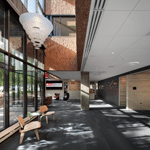Lighting designer Gregg Mackell doesn’t often work for free, but if the right offer comes along, why not? Scott Lindenau of Studio B Architects approached Mackell about doing the lighting design for the 4,290-square-foot AIA Colorado headquarters in Denver, a great opportunity for him to help out architects. “He asked if I could work for very little or no money, but architects are the reason I have business, so I jumped at the chance,” says Mackell, who founded Denver-based 186 Lighting Design Group in 2001.
The team sat down with a conceptual design, which involved a tenant finish of an existing high-rise office space. “Scott wanted to make the space substantially different, and his ideas were really cool,” Mackell says. “Studio B has a modern style and incorporated natural daylight with sustainable materials.”
Of course, there was one problem. When Lindenau and Mackell got estimates for the cost of the original design, it was roughly four times the budget. “We basically had to value engineer something like 75 percent out of the cost of the project,” Mackell says. Read more below.

Lit with sunlight and donated fixtures, the new AIA Colorado headquarters used existing building materials, such as the carpet tiles, lighting fixtures, and mechanical systems. Photo: Raul J. Garcia

In the office spaces, the lighting design work consisted of repurposing existing office lighting while introducing newer solutions, such as advanced controls.

“You just grab an iPad, and you can control the lights in the conference rooms and lobby,” explains Gregg Mackell, of 186 Lighting Design Group.
PROJECT
Location Denver
Size 4,290 ft2
Completed 2012
Program Office space
TEAM
Lighting Design 186 Lighting Design Group
Client AIA Colorado
Architect Studio B Architects, Hutton Architecture Studio
General Contractor Weitz Construction
GREEN
Certification Not applicable
Materials Native Coloradan beetle kill pine and other sustainable materials
Lighting LED troffers instead of fluorescents
Daylighting Extensive glass use in lobby, conference areas, and offices
Controls Lutron GRAFIK Eye controls for dimming and efficiency
To make that happen, Lindenau and Mackell asked for donations and discounts, which were somewhat less challenging to get—though certainly not easy—given that the AIA office is hosting the 2013 AIA National Convention. “We lost some cool lighting elements, like pattern projectors,” Mackell says, “but because we had a lot more pull with manufacturers than we normally would, we were able to maintain the integrity of the design.”
Upon entering the building, people are greeted by two large-scale decorative fixtures—one halogen pendant light and one fluorescent pendant light—donated by Visual Interest, Louis Poulsen Lighting and Studio Como, and the ceiling boasts the more functional LED-powered, four-inch square-aperture down lights manufactured by Tech Lighting.
In the office spaces, Mackell started by repurposing some of the existing incandescent A-lamp down lights by replacing bulbs with screw-in LED versions donated by GE Lighting. He also added 2’x2’ LED troffers (two-by-twos) manufactured by Finelite for general lighting. Over the conference table, Mackell used Architectural Lighting Works’ linear direct and indirect pendants with halogen-infrared MR16 lamps for task lighting and dimming fluorescent uplights. “The task lighting in the conference rooms gives us an infinite dimmability range, which is important when tenants are using projectors,” Mackell says.
Another notable lighting aspect of the project was the Lutron GRAFIK Eye lighting controls. In many commercial spaces, you have breakers or switches, but for this project, ESC Thul and CET & Associates donated a substantial amount of time and money in order to integrate iPads with everything in the conference rooms and general spaces. “You just grab an iPad, and you can control the lights in the conference rooms and lobby,” Mackell says.
One thing that surprised Mackell about the lighting design was the success of the LED two-by-twos. He had never used LED troffers in an office space and was leaning toward the building standard of fluorescent direct and indirect two-by-twos until Paul Hutton of Hutton Architecture Studio, who was on Lindenau’s team, pushed for two-by-two recessed LED fixtures. “We ended up going with what Paul recommended, and I was pleasantly surprised,” Mackell says. “We got a good volume of light from the LEDs, and the people who work in the office seem happy with their performance.”
In the end, Mackell says that the project’s budget constraints actually proved fortuitous because they led to a more energy-efficient office. The lighting team began with 0.9 watts per square foot; by the end, it was down to 0.8 watts. It appears that necessity really is the mother of innovation. gb&d

